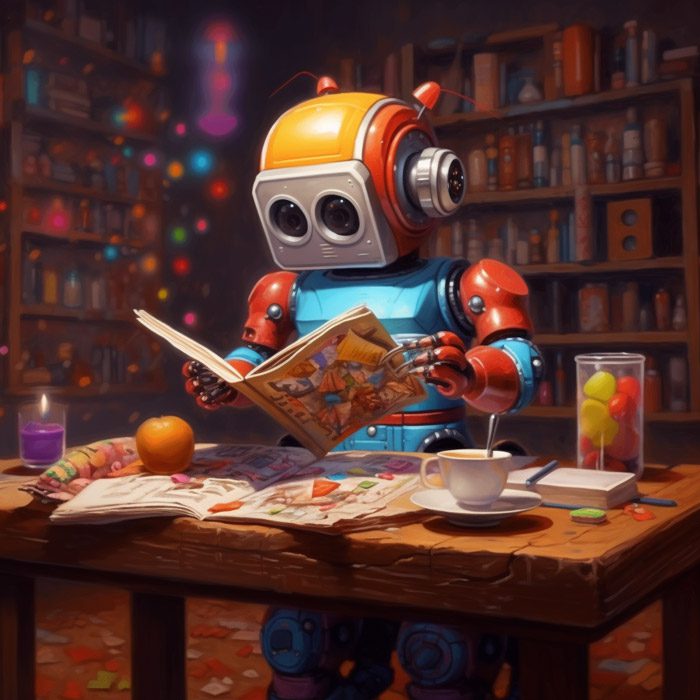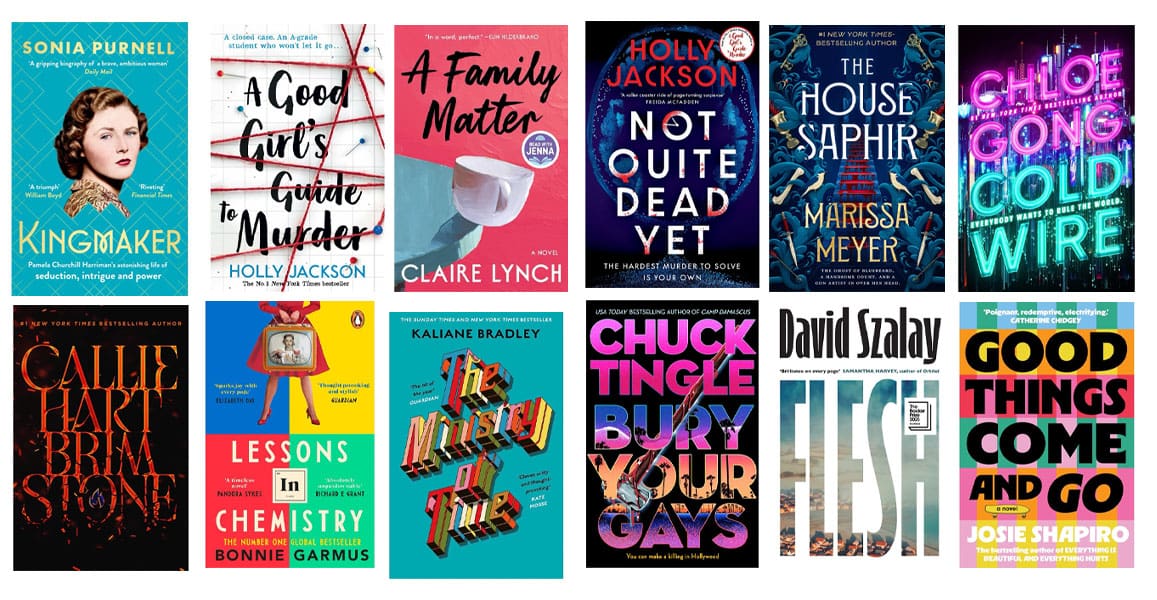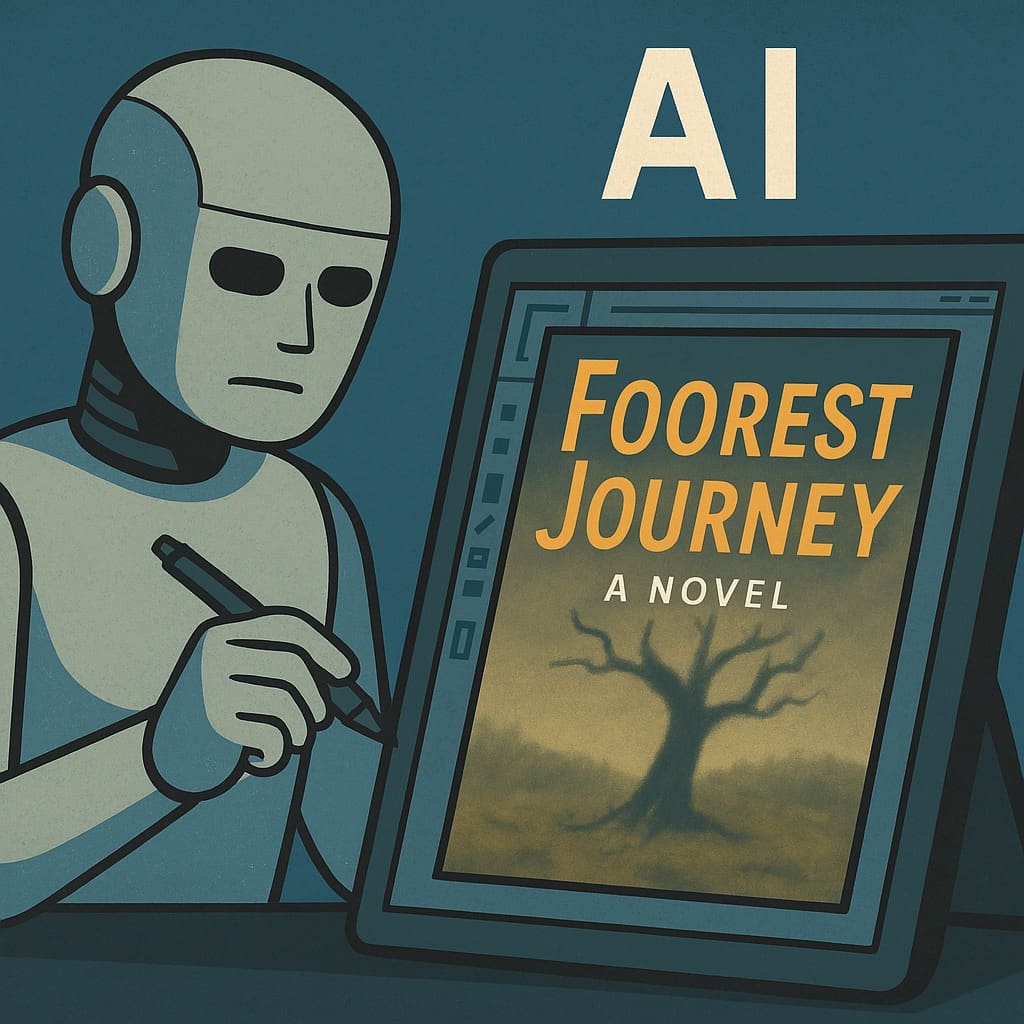It’s come with a rush.
Between ChatGPT and image generators like Midjourney and DALL·E, we now find ourselves in a world unrecognizable from the one we called home just 12 months ago.
If, in early 2022, you gave me two minutes to write 500 words on the impact of Elton John on eyewear culture AND create an image of Joe Rogan sitting in broth, I probably would’ve struggled. I no longer do.
As amazing as all this is, it can feel a little uncomfortable — and more than a little disconcerting — to the creatives in the room. Many professionals – writers, artists, coders, designers and more – are working to understand where technology fits into their process, what to keep human, what to delegate to machine, or whether to engage with the technology at all.
It’s something I’ve been grappling with myself. And I feel there’s no better time than now to discuss how AI might affect book cover design — and how we’re planning for this future at Damonza.
AI art: new, amazing, divisive, and here to stay
I’m in the book cover design business. Not engaging with AI isn’t really an option: I have a business to run, a team to support, and a future to build. To stand still is to move backwards. (Insert generic inspirational quote here.)
I’ve spent months thinking deeply about AI-generated imagery and how it affects design. I’ve studied it, tested it, and seen both its brilliance and its blind spots.
No matter how you feel about AI, here’s one thing we can all agree on: it’s not going away. The world’s biggest companies are fighting for dominance in generative AI. The genie isn’t going back in the bottle — it’s moved into your design software, set up a home office, and started making tea.
The basics of novels, book covers, and copyright
If you’re a self-published author, you probably know you can copyright your novel. Write it, file it, done.
But book covers? That’s different. Covers are made from fonts, illustrations, photos, design elements — each with their own copyright holder. The artist who created the font, the photographer who took the image — they own their pieces.
As cover designers, part of our job is ensuring everything on your cover is legally licensed. We build new covers using a mix of elements, but always ensure the final product is rights-safe.
Now, enter generative AI — and things get trickier.
The great AI debate: machine creation vs human originality
Here’s what’s changed since 2023:
- As of 2025, purely AI-generated works — with no meaningful human input — cannot be copyrighted in the U.S. The Copyright Office requires that “original works of authorship” be created by humans. AI-only work doesn’t qualify.
- If an AI determines the expressive elements of the output entirely on its own (i.e. you type a prompt and publish the image), the result isn’t protected by copyright. Someone else could recreate it with the same prompt and reuse it — legally.
- However, works that involve substantial human creative input — editing, compositing, integrating, art directing — can still be copyrighted.
This distinction is crucial for authors. If you use a full AI-generated image as your cover with no modification, you may not legally “own” it. But if a designer uses AI to generate elements and integrates them into a fully designed cover with creative human input? You’re covered.
For reference, the Copyright Office cited these principles again in 2025. Their statement:
“Works that use generative AI in their creative process or that include AI-generated material are eligible, as they still retain the centrality of human creativity… Extending protection to material whose expressive elements are determined by a machine, however, would undermine rather than further the constitutional goals of copyright.”
So… does this matter?
Here’s my personal take: it matters, but not as much as you might think.
Cover copyright is often misunderstood. Even before AI, most covers weren’t fully copyrightable — because they used stock imagery, licensed fonts, and layered elements. Two different authors could legally use the same stock photo on their covers. It’s happened. Many times.
So the fact that AI-generated imagery by itself isn’t copyrightable doesn’t fundamentally change the playing field. But the way we use AI — ethically, strategically, creatively — definitely does.
How Damonza uses AI (and why it’s copyright-safe)
At Damonza, we don’t use AI to generate entire covers. We may use it to generate individual elements — a character, a background, a weapon, a nebula — but the final cover is built by real designers.
We edit, layer, adjust lighting, set type, and carefully match tone and genre expectations. The final image isn’t just a raw AI output — it’s a fully realized, human-guided design.
Because of this, our covers are considered human-authored works — and we provide exclusive licenses to our clients. That means your rights are clear, your cover is legally usable, and you don’t need to worry about someone else generating the same image by accident.
Damonza’s 2025 Generative AI Image Policy
We use AI when it benefits the design — not to cut corners. Here’s our updated policy:
- Only individual elements are generated — never the full cover, and never typography.
- All AI-generated imagery is edited, styled, integrated, and art-directed by a human designer.
- No real people, celebrities, or artist names are used in prompts.
- All AI imagery is generated privately and with a commercial license.
- Authors may opt out of AI usage via our order form (though please note: with generative features now standard in design tools, full avoidance may become difficult).
If we use AI, you’ll know. We’re transparent, ethical, and careful — and the final result will always reflect the quality and originality we’re known for.
Want to go deeper?
We’ve covered every angle of this discussion in our full article series. Start with:
- AI in Design: Just Another Tool in a Cover Designer’s Toolkit
- Addressing Concerns: Understanding and Overcoming Hesitation
- Boosting Creativity: How AI Enhances Book Cover Design
Thanks for reading. If you’re not sure whether AI should be used in your cover? Just ask. We’ll give you the full picture (human-generated, of course).






3 Responses